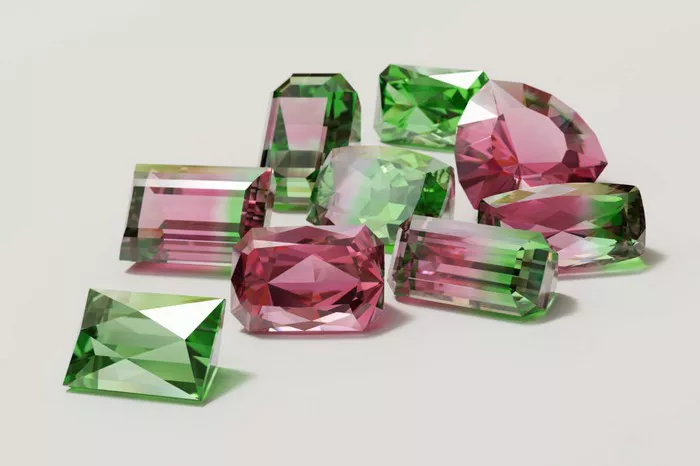Gemstones have captivated humanity for centuries, not only for their aesthetic appeal but also for their cultural significance and perceived metaphysical properties. Among these precious stones, the watermelon ruby stands out as a unique and exquisite marvel of nature. Combining the vibrant hues of pink and green, reminiscent of its namesake fruit, the watermelon ruby enthralls gemstone enthusiasts and collectors alike. In this comprehensive exploration, we delve into the origins, characteristics, symbolism, and market dynamics of this enchanting gem.
Origins and Formation
Watermelon rubies, also known as watermelon tourmalines, belong to the tourmaline family, a group of complex boron silicate minerals renowned for their diverse colors and compositions. The distinctive color zoning of watermelon rubies arises from variations in the concentrations of specific trace elements during their formation process.
These captivating gemstones form in pegmatite veins, which are coarse-grained igneous rocks typically found in association with granites. Pegmatites provide the ideal conditions for the crystallization of minerals due to their slow cooling rates and abundance of volatile elements. Within these geological formations, the intricate interplay of heat, pressure, and chemical interactions gives rise to the mesmerizing colors and crystal structures observed in watermelon rubies.
Characteristics and Color Variations
The hallmark of watermelon rubies lies in their striking coloration, which mimics the vibrant hues of a ripe watermelon. Typically, these gemstones exhibit a central core of pink or red, surrounded by concentric layers of green or sometimes yellow. This distinctive color zoning results from the presence of manganese and iron, which impart the pink and green hues, respectively.
In addition to their captivating coloration, watermelon rubies possess excellent transparency and clarity, making them highly desirable for use in jewelry. When expertly cut and polished, these gemstones display a remarkable brilliance and luminosity, further enhancing their visual appeal.
While the classic watermelon ruby showcases a pink-to-green gradient, variations in color intensity and zoning patterns contribute to a diverse array of aesthetic presentations. Some specimens may feature more subdued pastel tones, while others exhibit vivid, saturated colors that command attention. The uniqueness of each watermelon ruby ensures that no two gemstones are alike, adding to their allure and collectibility.
Symbolism and Metaphysical Properties
Throughout history, gemstones have been imbued with symbolic meanings and attributed various metaphysical properties by different cultures and belief systems. In the case of watermelon rubies, their distinctive color combination evokes notions of harmony, balance, and vitality.
The pink hues symbolize love, compassion, and emotional healing, while the green tones represent growth, renewal, and abundance. Together, these complementary colors embody the interconnectedness of the heart and the natural world, fostering a sense of harmony and equilibrium.
In metaphysical practices, watermelon rubies are believed to possess energetic properties that promote emotional well-being, enhance creativity, and facilitate spiritual growth. They are often associated with the heart chakra, the energy center responsible for love, empathy, and compassion. By wearing or meditating with watermelon rubies, individuals seek to align their energies with the universal flow of love and abundance, fostering inner peace and emotional resilience.
Market Dynamics and Valuation
The market for watermelon rubies has witnessed significant growth in recent years, driven by increasing demand from collectors, designers, and aficionados seeking unique and distinctive gemstones. The rarity of high-quality specimens, coupled with their captivating beauty, has contributed to a surge in prices and a burgeoning market niche within the gemstone industry.
Factors such as color intensity, clarity, size, and origin play crucial roles in determining the value of watermelon rubies. Gemstones exhibiting vivid, well-defined color zoning, accompanied by excellent transparency and minimal inclusions, command premium prices in the market. Additionally, specimens sourced from renowned mining locations, such as Brazil, Mozambique, and Afghanistan, often carry a premium due to their perceived quality and rarity.
Despite their growing popularity, watermelon rubies remain relatively niche compared to other gemstones such as diamonds, sapphires, and emeralds. This exclusivity adds to their allure and investment potential, as collectors and investors seek to acquire these unique treasures for their beauty and scarcity value.
Conclusion
In conclusion, watermelon rubies stand as exquisite examples of nature’s artistry, blending vibrant colors, crystalline structures, and symbolic significance into captivating gemstones. From their origins in the depths of the Earth to their place as cherished adornments and metaphysical talismans, watermelon rubies continue to captivate hearts and minds around the world.
Whether admired for their aesthetic beauty, valued for their metaphysical properties, or coveted for their investment potential, watermelon rubies hold a special place in the realm of gemstones. As appreciation for these natural wonders grows, so too does the allure of the watermelon ruby, a delicate masterpiece crafted by the hands of time and the forces of nature.


